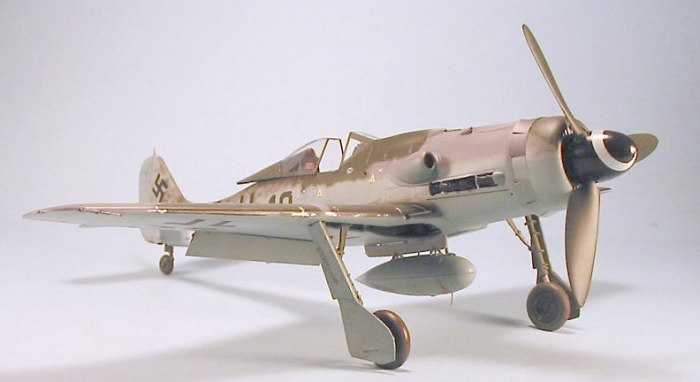
|
KIT: |
Hasegawa 1/32 FW-190D-9 |
|
KIT # |
08069 |
|
PRICE: |
$39.95 MSRP |
|
DECALS: |
Three options |
|
REVIEWER: |
Tom Cleaver |
|
NOTES: |

|
HISTORY |
The Lang‑Nasen Dora could possibly have entered Luftwaffe service in 1943, had Kurt Tank been less insistent on fighting the Reichluftfahrtministerium (RLM) over the powerplant of the new development of the famous "Butcher Bird." Had this happened, the airplane might have had more effect on the war, as it would have outclassed both the P‑38 and the P‑47 ‑ the two escort fighters of the 8th AF at the time ‑ and would have been more than a handful for the P‑51B Mustang when it came along, particularly since the quality of pilots in 1943 would have been far better than those who flew it during the final seven months of the war when it saw widespread service.
The Dora‑9 served with the best units the Luftwaffe had to offer, but by the fall of 1944, these units were mere shadows of their former selves.
The first unit
to equip with the new fighter, in September and October 1944, was
III/JG54, commanded by Hauptmann Robert "Bazi" Weiss. The unit had been
the outstanding Jagdgruppe in the fighting over Normandy the
previous summer, but the success had come at a high price, with the unit
scoring about a 2:1 kill ratio and losing the last of its experienced
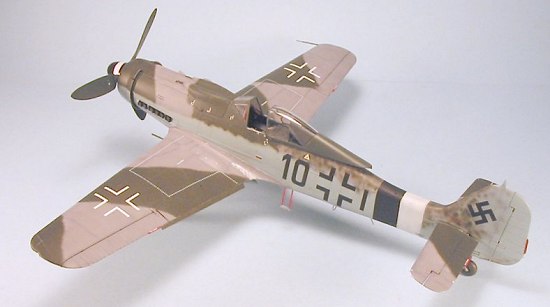 pilots at the level below Staffelkapitaen. The unit that took delivery
of the first Dora‑9s had a core of successful veterans,
Staffelkapitaene such as Leutnant Peter Crump, who had joined JG26 as
an NCO pilot on the Channel Front in 1942, but all the rest were
Nachwuchs ‑ "new growth" ‑ young pilots fresh from flight school with
less than 200 hours total flight time whose major accomplishment was not
crashing the high‑performance fighters they were assigned. After the
blood‑letting of "The Battle of Germany" in the Spring of 1944, when the
fighters of the Eighth Air Force had shot down and killed 40 percent of
their Luftwaffe opponents, the Luftwaffe had paid the price of not having
planned for a long war in their replacement training.
pilots at the level below Staffelkapitaen. The unit that took delivery
of the first Dora‑9s had a core of successful veterans,
Staffelkapitaene such as Leutnant Peter Crump, who had joined JG26 as
an NCO pilot on the Channel Front in 1942, but all the rest were
Nachwuchs ‑ "new growth" ‑ young pilots fresh from flight school with
less than 200 hours total flight time whose major accomplishment was not
crashing the high‑performance fighters they were assigned. After the
blood‑letting of "The Battle of Germany" in the Spring of 1944, when the
fighters of the Eighth Air Force had shot down and killed 40 percent of
their Luftwaffe opponents, the Luftwaffe had paid the price of not having
planned for a long war in their replacement training.
JG26 Carries On:
II/JG26 had been withdrawn from operations in November 1944, to become the second Jagdgruppe to convert to the Dora‑9. They were followed in early December by I/JG26, which was not withdrawn from operations during its conversion process. By the time the Battle of the Bulge opened on December 16, 1944, the two premier Fw‑190 Gruppen on the western front were fully equipped with the latest version of the Butcher Bird.
The two units participated in the last large‑scale Luftwaffe attack of the war, Operation Bodenplatte, the New Year's Day mission against the Allied airfields in Belgium that should have opened the German offensive two weeks earlier, and could as well have been planned by the Allies ‑ given its effect on the Jagdwaffe ‑ as by the incompetent General Dietrich Pelz, a bomber commander who now had Goering's ear. The Allies' aircraft losses were made up within a week; the Jagdwaffe never recovered in the rest of the war. Thirty percent of the German Gruppenkommandure and Staffelkapitaene formation leaders were among those killed or taken prisoner.
After the
retreat from France, JG26 had become a frontline Geschwader,
facing the British of 2TAF in the low countries after the lines
stabilized following the failure of Operation Market Garden. In the
terrible winter that followed Bodenplatte - the worst winter in
Europe in a century - the unit never flew more than 4‑5 missions a month
due to weather, and suffered
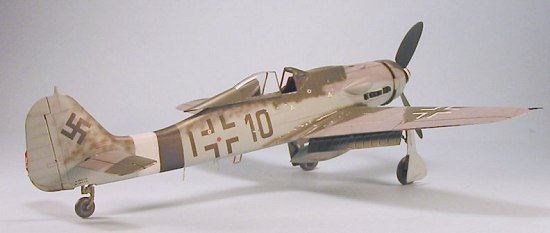 losses of 25‑30 percent each time, though
their kill ratio was still on the level of 1.5:1 in their favor during
this time. What was happening was, the experienced survivors like Adolf
"Addi" Glunz, who scored over 80 kills as an enlisted pilot between 1941
and 1944 with JG26 - while becoming the only German experte
on the Western Front to never be shot down! ‑ were scoring as they had,
due to the fact the Allies were scraping the bottom of the barrel, too,
while a Nachwuchs like Obergefreiter Werner Molge, at 19
the youngest pilot in JG26 and considered something of a "mascot" by the
other pilots, was lucky to survive any mission flown against pilots who
had a minimum of three times as much flight experience as he did.
Battles at this time were short and sharp, in bad weather, with losses
high on both sides.
losses of 25‑30 percent each time, though
their kill ratio was still on the level of 1.5:1 in their favor during
this time. What was happening was, the experienced survivors like Adolf
"Addi" Glunz, who scored over 80 kills as an enlisted pilot between 1941
and 1944 with JG26 - while becoming the only German experte
on the Western Front to never be shot down! ‑ were scoring as they had,
due to the fact the Allies were scraping the bottom of the barrel, too,
while a Nachwuchs like Obergefreiter Werner Molge, at 19
the youngest pilot in JG26 and considered something of a "mascot" by the
other pilots, was lucky to survive any mission flown against pilots who
had a minimum of three times as much flight experience as he did.
Battles at this time were short and sharp, in bad weather, with losses
high on both sides.
JG26's main opponents were the Tempest Vs, at the time the main RAF medium-altitude air superiority fighter. Between their arrival on the continent shortly before the opening of the Battle of the Bulge and the end of the war, the Tempests of 84 group ‑ whose mission was "air superiority" over the Luftwaffe ‑ suffered 115% losses in pilots killed, wounded and taken prisoner. The air war over northwestern Europe at the end of the war was as bloody as anything that happened over the Somme a generation before.
When the Allies crossed the Rhine at Remagen in March, 1945, following it at the end of the month with "Operation Varsity" - the airborne crossing of the lower Rhine - the end of World War II in Europe was in sight. JG 26 withdrew progressively to fields in Schleswig, just south of Denmark. Fuel was at a premium, and few flights were flown, though some victories were still obtained. On April 4, 1945, 7.JG26 caught allied armor near their former base of Nordhorn, and were able to make a bombing strike that took out ten enemy tanks with no losses to the Germans. Two days later, IV/JG26 ‑ which had been III/JG54 until late February 1945 ‑ was disbanded and its surviving pilots absorbed into I/JG26. Oberleutnant Peter Crump, who had survived his time with III/JG54, became 10th Staffelkapitaen in I/JG26, where he would continue to fly to the end of the war in his Schwarz Zehn. A week later, III/JG26 ‑ which had only exchanged its Bf‑109K‑4s for Fw‑190D‑9s a month earlier ‑ was also disbanded and its pilots sent to flesh out II/JG26.
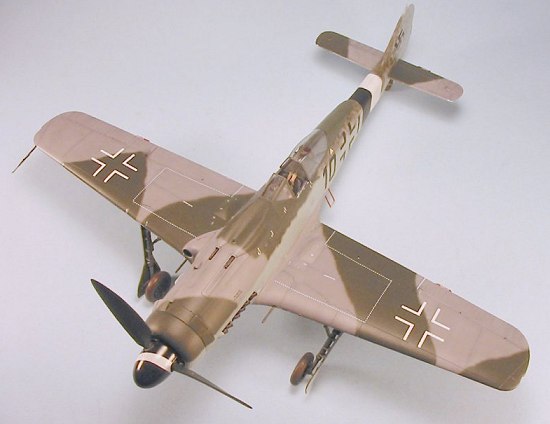 By this point,
there were no Eastern and Western fronts left for the Germans. JG26
pilots were flying missions over Berlin in mid‑April, fighting the
Russians. On April 25, 1945, Leutnant Siegfried Sy of 7th Staffel,
II/JG26, scored the 903rd and last victory of the most successful Fw‑190
Gruppe of the Luftwaffe ‑ a Russian P‑39 Airacobra over
Berlin. On April 26, 2nd Staffel of I/JG26 staged in to the former
Luftwaffe test center at Rechlin, then flew a special mission into
Berlin. A 13th Fw‑190D‑9 accompanied them, flown by General Robert
Ritter von Greim, with the well‑known aviatrix Hanna Reitsch crammed into
the baggage compartment; it was the first stage of their lunatic mission
to the Fuehrerbunker in Berlin, which resulted in von Greim being
named head of the Luftwaffe after Hitler ordered the arrest of Goering
when it was discovered he was attempting to negotiate to surrender in the
West.
By this point,
there were no Eastern and Western fronts left for the Germans. JG26
pilots were flying missions over Berlin in mid‑April, fighting the
Russians. On April 25, 1945, Leutnant Siegfried Sy of 7th Staffel,
II/JG26, scored the 903rd and last victory of the most successful Fw‑190
Gruppe of the Luftwaffe ‑ a Russian P‑39 Airacobra over
Berlin. On April 26, 2nd Staffel of I/JG26 staged in to the former
Luftwaffe test center at Rechlin, then flew a special mission into
Berlin. A 13th Fw‑190D‑9 accompanied them, flown by General Robert
Ritter von Greim, with the well‑known aviatrix Hanna Reitsch crammed into
the baggage compartment; it was the first stage of their lunatic mission
to the Fuehrerbunker in Berlin, which resulted in von Greim being
named head of the Luftwaffe after Hitler ordered the arrest of Goering
when it was discovered he was attempting to negotiate to surrender in the
West.
Heavy rain restricted flying for the rest of the war. The last combat mission flown by JG26 came on May 4, 1945, an indecisive flight in rain. That night, I/JG26 was ordered by von Greim to fly to Prague, an idiotic mission that would have had the unit land on airfields controlled by the Russians. Major Karl Borris, the by‑the‑book Kommandeur of I/JG26 faced a mutiny by his pilots when he said they would follow orders; bad weather prevented the flight and provided an excuse not to court‑martial the mutineers. II/JG26 had no Kommandeur, since their last had been killed on April 25. Some of the pilots ‑ led by avowed Nazi Leutnant Siegfried Sy ‑ flew to Bergen, Norway, before the armistice became final on May 5. On May 6, Major Borris led his men in a surrender to the British at Flensburg. The remaining pilots of II/JG26 surrendered the following day. Interestingly, the Dora-9s of JG26 would become the aircraft that would survive to sit in air museums today.
|
THE KIT |
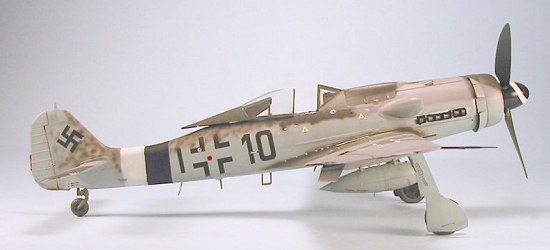 There have been
other 1/32 kits of the Focke-Wulf Fw-190D-9 that were released in the
1970s. For all intents and purposes, those kits are now large "door
stops," with the release of this all-new 1/32 Dora by Hasegawa.
There have been
other 1/32 kits of the Focke-Wulf Fw-190D-9 that were released in the
1970s. For all intents and purposes, those kits are now large "door
stops," with the release of this all-new 1/32 Dora by Hasegawa.
The Dora is crisply-molded, and engineered in such a way that it is obvious they will continue the Hasegawa policy of milking out every sub-type of an airplane that can be done with minimal changes to the parts selection. Most importantly, this is the first Dora kit that has the open wheel well and provision of the rear section of the Jumo powerplant.
The kit decals, at least as far as the two aircraft from the Papagei Staffel are concerned, are inaccurate and best replaced with the aftermarket sheet "Doras of the Galland Circus" produced by Eagle-Editions.
|
CONSTRUCTION |
This kit is very well-designed, and goes together so easily that a modeler really has to go out of their way to mess up the assembly.
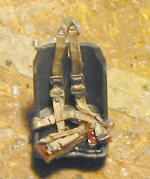 Modelers can
get any one of the "super kit" resin upgrades for this that are being
produced by aftermarket companies the way Hermann Goering told Kurt Tank
to produce the Fw-190 ("like hot rolls"), but the problem is that when
it's assembled, there is not that much there to be seen in an Fw-190
cockpit (as stated above). For this kit, I used the kit cockpit,
supplementing it with a Cutting Edge 1/3
Modelers can
get any one of the "super kit" resin upgrades for this that are being
produced by aftermarket companies the way Hermann Goering told Kurt Tank
to produce the Fw-190 ("like hot rolls"), but the problem is that when
it's assembled, there is not that much there to be seen in an Fw-190
cockpit (as stated above). For this kit, I used the kit cockpit,
supplementing it with a Cutting Edge 1/3 2 posable resin seatbelt set,
which is really about all one really needs with this kit.
2 posable resin seatbelt set,
which is really about all one really needs with this kit.
I next painted all the engine parts per instructions, then assembled that sub-assembly.
After gluing the cockpit tub and engine bay and exhaust tubs into position, I glued the fuselage together. I had previously glued each tail half to its respective fuselage half at the outset. There was almost no centerline seam. Do remember: the rear fuselage does have a centerline seam (like the Bf-109), and it is correctly offset to the right in the fuselage extension. You'll only need a bit of Mr. Surfacer 1000 for the seam on the upper engine cowl, since the lower centerline seam is correct for the panels that are opened to service the engine. I attached the horizontal stabilizers and finished the sub assembly by attaching the radiator and cowling, opting for the open-flaps look.
 Having already
pre-painted the wheel wells when I pre-painted the other interior parts,
assembly of the wing was a breeze. The wheel well is attached to a wing
spar that absolutely guarantees the wing will have the correct dihedral.
This is as important a point as the engineering of the gear legs, since
incorrect dihedral and improperly-aligned landing gear are the to major
places where modelers "screw the pooch" when they build Fw-190 models
previous to this one.
Having already
pre-painted the wheel wells when I pre-painted the other interior parts,
assembly of the wing was a breeze. The wheel well is attached to a wing
spar that absolutely guarantees the wing will have the correct dihedral.
This is as important a point as the engineering of the gear legs, since
incorrect dihedral and improperly-aligned landing gear are the to major
places where modelers "screw the pooch" when they build Fw-190 models
previous to this one.
Attachment of the wing to the fuselage is a bit "fiddly. However, test-fitting a couple times to see what was what insured that when I did apply glue, I knew how to make the parts "snap together." The rear wing root joint on both wings seemed to want to pop loose. I fixed this by applying some cyanoacrlyate to the area through the flap well, and held the joint in position until the glue hardened.
It was time to head to the paint shop.
|
COLORS & MARKINGS |
Painting:
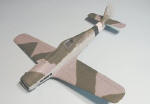 I first
"pre-shaded" the model by roughly airbrushing flat black over all panel
lines and ribs. I then masked off the black stripe of the JG 26 Reichverteidigung band. I painted the white band and masked it off. We
were ready for camouflage.
I first
"pre-shaded" the model by roughly airbrushing flat black over all panel
lines and ribs. I then masked off the black stripe of the JG 26 Reichverteidigung band. I painted the white band and masked it off. We
were ready for camouflage.
This Fw-190D-9 was an early one, by the fact of it having a 600xxx serial
number, which means that it was most likely camouflaged with RLM76 lower
surfaces, and RLM75 and RLM81 upper surface
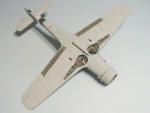 camouflage.
camouflage.
The upper surfaces were painted with Gunze-Sangyo paints. I use their "Medium Sea Grey," which has a distinct violet hue, as RLM75, and made my own mixture of RLM83 Dark Green, using a standard Fw-190D-9 camouflage pattern from an Eagle-Editions decal instruction sheet. The spinner and prop blades were painted RLM70. When all was dry, I gave the model a coat of Future.
Decals:
I was doing this Black 10 from photos of JG26 Dora-9s after their surrender in 1945, as published in “JG26: Top Guns of the Luftwaffe.” Decals were used from various 1/32 Focke-Wulf sheets, pieced together for this frontline fighter.
|
FINAL CONSTRUCTION |
I applied exhaust staining using my Future-with-black wash, with repeated passes to darken it.
I then attached the exhausts, which are a bit fiddly to do, but not impossible.
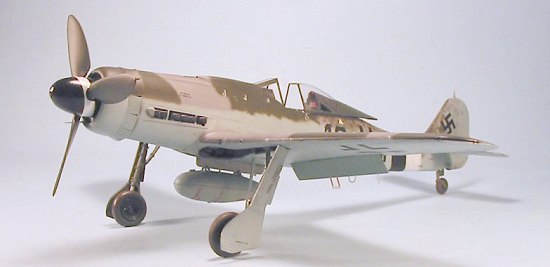 The landing
gears were assembled, and gear doors attached. I "weathered" the tires by
dry-brushing Tamiya "Red-Brown" to simulate the mud worn into the tires
from operation off a dirt strip.
The landing
gears were assembled, and gear doors attached. I "weathered" the tires by
dry-brushing Tamiya "Red-Brown" to simulate the mud worn into the tires
from operation off a dirt strip.
Assembly of the landing gear is a breeze. The only way a modeler could commit the major mistake of Fw-190 modelers - misalignment of the landing gear - would be to physically break the gear. The assembly is perfectly engineered so that all one has to do is push the landing gear leg into its attachment hole, and it is in proper position. Those of you who think the landing gear on an FW-190 sticks straight down will be surprised to find out it doesn't. Modelers can successfully use this model as a guide for correcting their 1/48 and 1/72 Butcher Birds to correct that problem.
|
CONCLUSIONS |
This is one of the best kits in any scale it has ever been my pleasure to build. There's more to it than just assembly, but the physical kit is so well-designed you can concentrate on getting its look right as regards painting. At a price of US$39.95 - not that much more than many 1/48 kits these days - you can afford to build more than one, and I have seen the model priced as low as US$33.00. There is a plethora of interesting markings for the airplane from the aftermarket. Personally, when it comes to Fw-190D-9s, I choose Eagle Editions decals hands-down, just because I know that Jerry "Mr. Dora-9" Crandall designed them; if there's something he doesn't know about this airplane, no one else knows it either.
This Hasegawa Dora-9 model is fun to build. I can't recommend it more highly than that. (The editor agrees and this has to be at least the fourth of these big birds that Tom has done!)
Kit courtesy of my wallet.
August 2004
If you would like your product reviewed fairly and quickly by a site that has over 250,000 visitors a month, please contact me or see other details in the Note to Contributors.